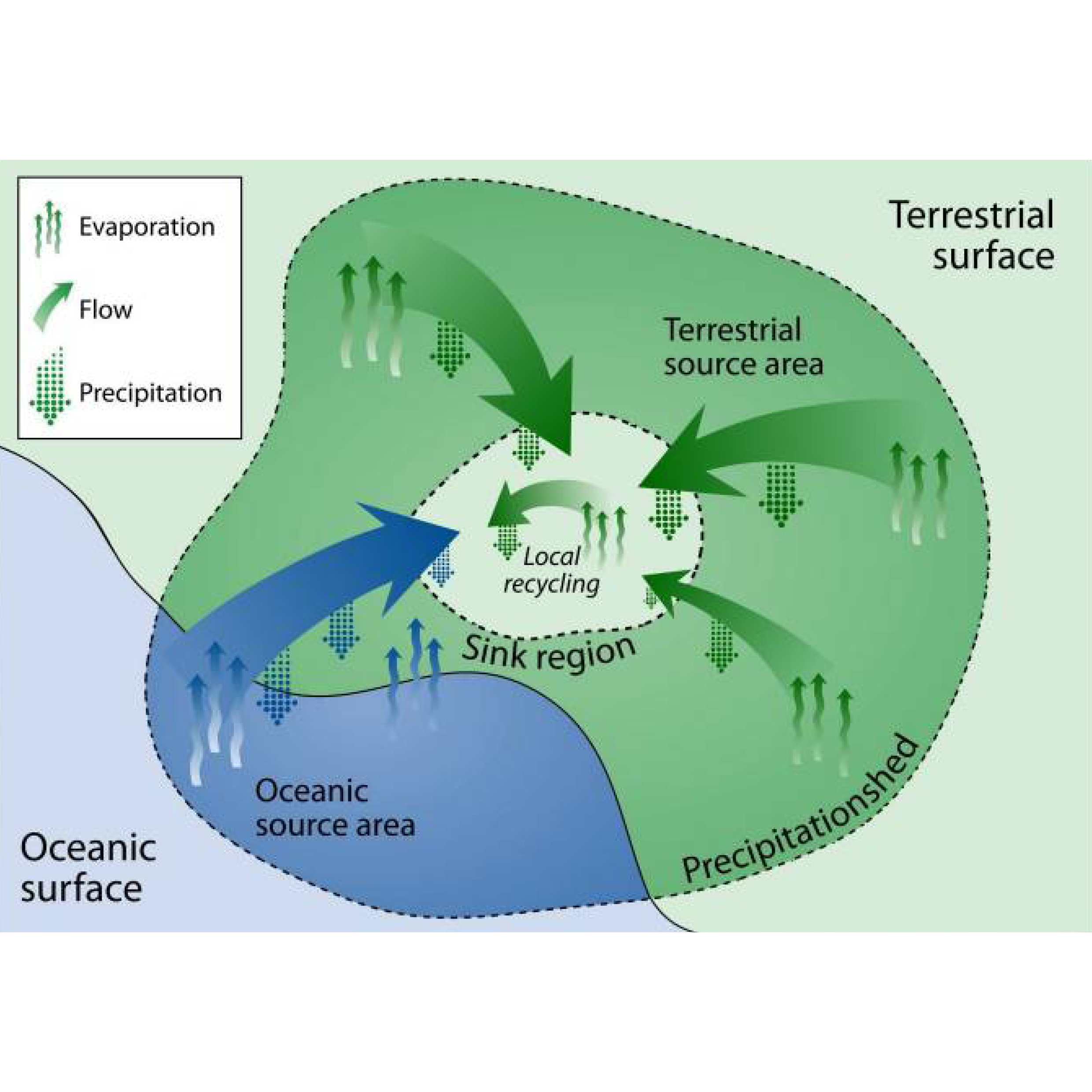
Evaporation is the process of turning from a liquid into a vapour. Natural soils in the earth are characterised by their high evaporation rates. The greatest part of stormwater is discharged by evapotranspiration. With 19 of the 29 largest cities in the world depending on evaporation from surrounding lands for more than one-third of their water supplies, evaporation is more critical to help with the increase in urban population growth. Most of these cities rely on surface water from either direct rain runoff, snow or glacial melt. For example, Mount Patscherkofel in Austria, where the water vapor is recycled back by 2.5-3% of the local precipitation of the city of Innsbruck.
Moisture recycling occurs when water evaporates from the land and rises up into the atmosphere. This moisture then flows along prevailing wind currents through the atmosphere, falling out as precipitation elsewhere. Advances in global modeling track the atmospheric moisture flowing around the planet and can identify the specific locations where moisture enters the atmosphere as evaporation, and where it falls out as precipitation. For example, Vienna’s evaporation takes place in the summer with a mean annual evaporation between 450 mm and 650 mm for the Danube River.
A precipitationshed defines a spatial boundary enclosing upwind evaporative sources of downwind precipitation and receives precipitation from an upwind source and from within itself. There can be many buffers between precipitation falling in a watershed and the water that flows into a city’s pipes, including dam storage, transport via canals, and storage in local reservoirs. For Buenos Aires, the watershed encompasses the entire La Plata basin with high amounts of moisture recycling processes occurring within the basin itself. The cities with less buffers can receive more water from moisture recycling. Changing the amount of water or when it evaporates and flows up into the atmosphere in an area can have impacts for other places and people, such as large scale deforestation for farming. Reservoirs, treatment and desalination plants are potential safeguards to mitigate climate change for cities water management.
Moisture recycling occurs when water evaporates from the land and rises up into the atmosphere. This moisture then flows along prevailing wind currents through the atmosphere, falling out as precipitation elsewhere. Advances in global modeling track the atmospheric moisture flowing around the planet and can identify the specific locations where moisture enters the atmosphere as evaporation, and where it falls out as precipitation. For example, Vienna’s evaporation takes place in the summer with a mean annual evaporation between 450 mm and 650 mm for the Danube River.
A precipitationshed defines a spatial boundary enclosing upwind evaporative sources of downwind precipitation and receives precipitation from an upwind source and from within itself. There can be many buffers between precipitation falling in a watershed and the water that flows into a city’s pipes, including dam storage, transport via canals, and storage in local reservoirs. For Buenos Aires, the watershed encompasses the entire La Plata basin with high amounts of moisture recycling processes occurring within the basin itself. The cities with less buffers can receive more water from moisture recycling. Changing the amount of water or when it evaporates and flows up into the atmosphere in an area can have impacts for other places and people, such as large scale deforestation for farming. Reservoirs, treatment and desalination plants are potential safeguards to mitigate climate change for cities water management.
Wershed of the sky that identifies the origin of precipitation falling in a given region.
Sources: Patrick W Keys, Lan Wang-Erlandsson, and Line J Gordon, “Megacity Precipitationsheds Reveal Tele-Connected Water Security Challenges,” PloS one (Public Library of Science, March 13, 2018), https://www.ncbi.nlm.nih.gov/pmc/articles/PMC5849328/.
Sources: Patrick W Keys, Lan Wang-Erlandsson, and Line J Gordon, “Megacity Precipitationsheds Reveal Tele-Connected Water Security Challenges,” PloS one (Public Library of Science, March 13, 2018), https://www.ncbi.nlm.nih.gov/pmc/articles/PMC5849328/.
- Mary Guiden, “World's Largest Cities Depend on Evaporated Water from Surrounding Lands,” Colorado State University (Colorado State University, March 13, 2018), https://source.colostate.edu/worlds-largest-cities-depend-on-evaporated-water-from-surrounding-lands/.
-
Patrick W Keys, Lan Wang-Erlandsson, and Line J Gordon, “Megacity Precipitationsheds Reveal Tele-Connected Water Security Challenges,” PloS one (Public Library of Science, March 13, 2018), https://www.ncbi.nlm.nih.gov/pmc/articles/PMC5849328/.
